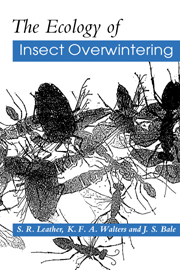Foreword
Published online by Cambridge University Press: 16 September 2009
Summary
The study of insect overwintering has largely concentrated on a few well defined areas of study. Whether this has been the result of the understandable reluctance of entomologists to expose themselves to the rigours of the great outdoors during what is one of the more taxing times of the year or to the fact that the importance of the overwintering stage in relation to the population dynamics of a particular species has been underestimated, is a moot point.
Be that as it may, it is a fact that a large proportion of a temperate or polar insect's life cycle is spent in the overwintering stage and recent work within allied groups, e.g. red spider mite, and within insect groups such as the Aphidoidea, has highlighted the advantages, in terms of control and prediction, to be gained from a detailed knowledge of insect overwintering habits. The contents in each chapter of this book have been largely determined by the availability of published work and by what we have considered to be the more important aspects of this subject. However, we have included previously unpublished material in an attempt to make this a comprehensive and enlightening addition to the field. The overwintering habits of some insect groups have been largely ignored by the entomological world and we have tried, where possible, to point out areas where future research would be profitable.
- Type
- Chapter
- Information
- The Ecology of Insect Overwintering , pp. ix - xPublisher: Cambridge University PressPrint publication year: 1993

